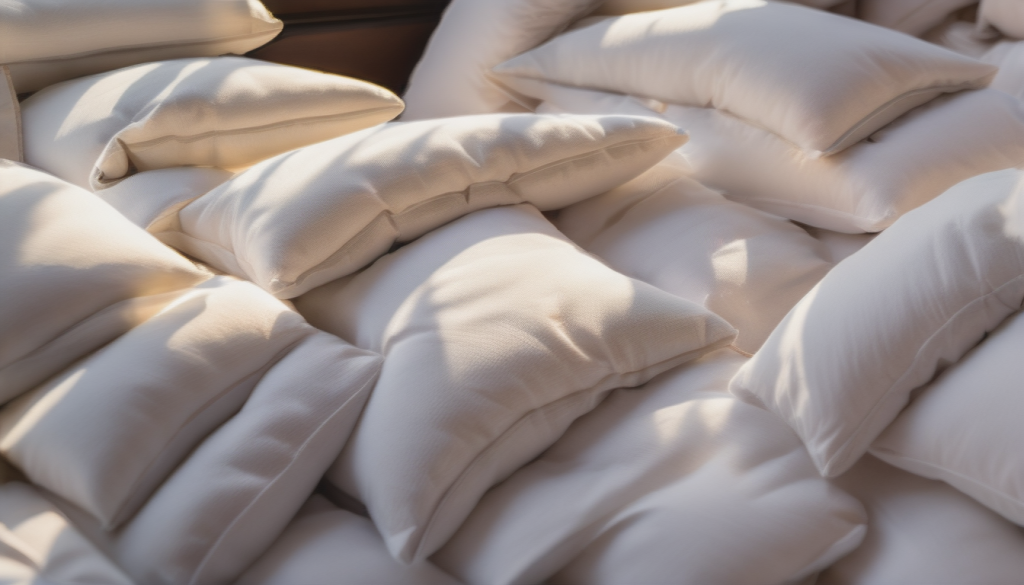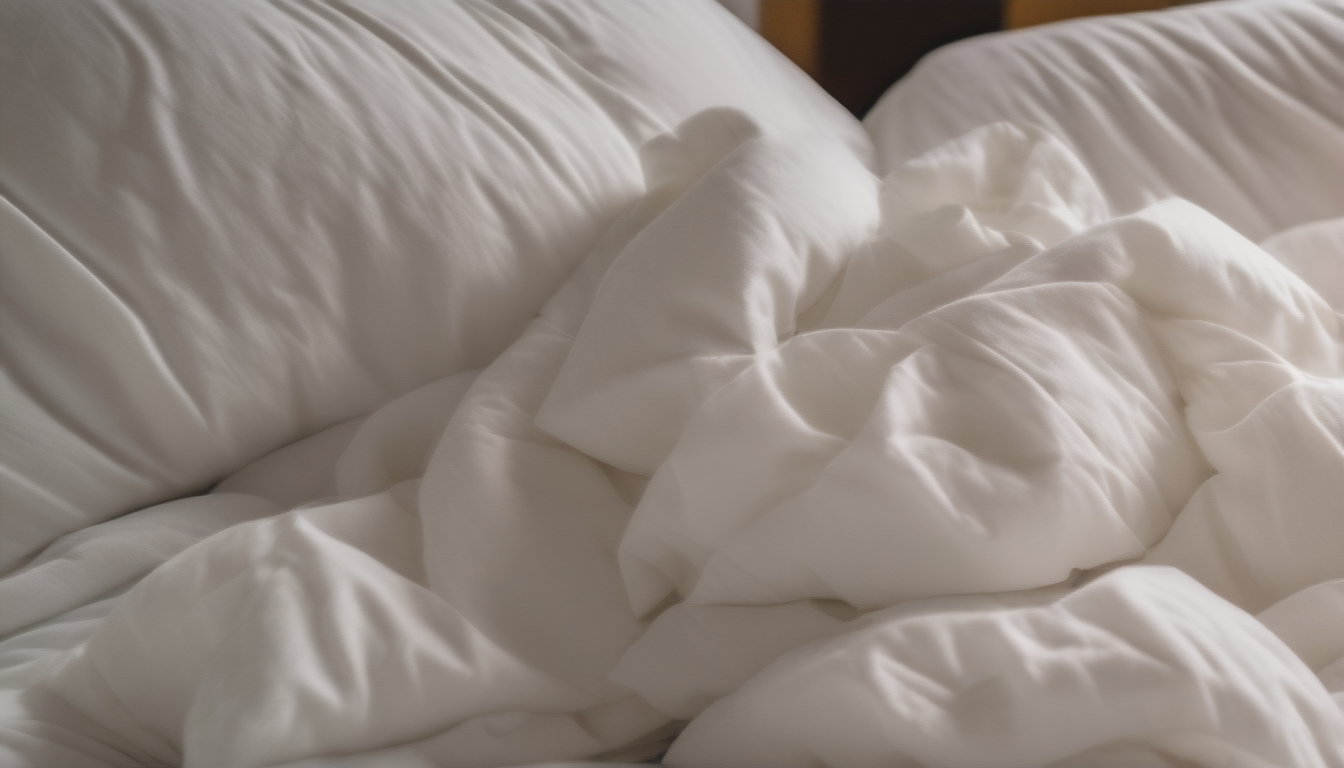For many, a plush down comforter is the ultimate in luxury bedding. Down offers unmatched warmth and softness. But recently, concerns have emerged about potential toxins in down comforters and their impact on health and safety.
This beginner’s guide tackles the debate around down bedding. Are those fluffy comforters safe, or should you opt for an alternative? Let’s weigh the facts.
What is Down and How is it Used in Comforters?
Down refers to the fine, fluffy clusters that form the base layer of feathers in ducks and geese. This delicately insulating material makes an incredibly warm and lightweight fill for duvets, pillows, and bedding.
- Down comforters consist of an outer fabric shell or cover stuffed with down fill. Most feature a poly-cotton shell and down cluster fill.
Many choose down because it offers superior:
- Warmth
- Softness
- Breathability
- Lightness
- Durability
But down is not without some important considerations around sourcing, allergies, and toxicity.
Are the Chemicals in Down Comforters Toxic?
While down itself is natural, concerns have emerged around production methods and chemical additives. Here are some of the most salient worries:
Pesticides and Chemical Fertilizers on Down Farms
- Most down is farmed in China and Eastern Europe on industrial scales. This involves liberal use of pesticides and chemical fertilizers known to be toxic to humans.
- These agricultural chemicals remain in the down through processing and find their way into finished bedding products.
Bleaches, Biocides, and Other Chemical Additives
- The down itself goes through extensive processing once collected from the birds. This involves bleaching and sterilizing using harsh chemicals like chlorine bleach and formaldehyde.
- Other concerning treatments include antibacterial agents, antimicrobials, water repellents, and stain guard chemicals. All pose health issues.
Flame Retardants Sprayed on Finished Products
- Many manufacturers spray finished down bedding products with flame retardant chemicals in an effort to meet flammability standards.
- These contain compounds that research links to hormonal disruption, neurological impairment, and cancer.
So clearly, there are valid concerns around toxin exposures from down bedding despite the appeal of natural down clusters.
Next, let’s explore the potential health implications.
Can Down Comforters Cause Feather Duvet Lung?
One of the most worrying associations with down bedding is the risk of Feather Duvet Lung.
Sometimes called feather duvet disease (FDD) or feather lung disease, this condition involves inflammation and scarring of lung tissue from exposure to dust and particles from feather and down bedding.
Feather Duvet Lung Symptoms
Those with Feather Duvet Lung may experience:
- Chronic dry cough
- Shortness of breath
- Tightness in the chest
- Night sweats
If left untreated, permanent lung damage can occur.
Causes and Mechanisms
Research identifies feather and down particles as triggers for Feather Duvet Lung. Exact mechanisms remain unclear but may involve:
- Innate inflammatory reaction to feather dust
- Allergic response to avian antigens
- Additive toxicity from pesticides and chemical residues
Regardless of the causes, research clearly links feather bedding with respiratory inflammation and Feather Duvet Lung risk. Those already dealing with lung issues face highest risk.
Can Down Trigger Allergies or Asthma Flare-Ups?

Beyond lung inflammation, down feathers carry proteins that can trigger allergic reactions or asthma attacks in the sensitive. Reactions may manifest as:
- Wheezing
- Runny nose
- Itchy skin
- Hives
However, it’s important to note down itself does not inherently cause allergies. Rather, down can trigger hypersensitivity pneumonitis in those with a preexisting allergy to avian antigens.
Healthier Alternatives to Down Comforters
Given the respiratory risks of down bedding, many seek alternative fills and fabrics. Top options include:
Down Alternatives
- Polyester fills mimic down’s qualities at a lower cost and without allergens. However, polyester is petroleum-based.
- Cotton offers a hypoallergenic, renewable fill source. However, conventional cotton relies heavily on pesticides and chemical fertilizers.
Natural Materials
- Organic wool serves as a premium hypoallergenic alternative. It avoids chemicals but costs more.
- Hemp makes an innovative, sustainable filler option but lacks warmth.
How Green and Ethical is the Down Supply Chain?
Beyond toxicity concerns, animal welfare and sustainability issues plague much of the down industry:
- Conventionally farmed geese often endure cruel practices like live-plucking.
- Unethical sourcing means most down carries few welfare guarantees.
- Processing uses extensive water, energy, and chemical resources.
However, conscientious consumers can find ethically sourced down certified to higher standards. Key certifications to look for include:
- Responsible Down Standard (RDS)
- Global Organic Textile Standard (GOTS)
- Textile Exchange Content Claim Standard (CCS)
These verify humane animal treatment and responsible production methods.
The Case For and Against Down Comforters
| The Case For Down | The case Against Down | |
|---|---|---|
| Warmth & Breathability | Unmatched for lightweight warmth and breathability allowing adjustable comfort | Alternative fills often less breathable leading to sleeping hot or cold |
| Comfort & Softness | Extreme coziness and luxurious sunk-in feel | Occasionally too heavy; requires frequent redistribution of fill |
| Longevity | With care, lasts 30+ years | Requires special maintenance like re-fluffing |
| Allergen Resistance | Can provoke allergies and lung inflammation | Hypoallergenic options available |
| Cost | Similar or cheaper than quality alternatives | Ethical down costs more; covered under warranty less |
Given these trade-offs, personal factors like allergies and ethics may dictate your ideal comforter fill.
Seeking a Non-Toxic Down Alternative Comforter? What to Know
For those seeking down alternatives, focus on the following to identify quality non-toxic options:
- Fill Power: This measures both warmth and density. Choose options with fill power between 400-800.
- Fill Weight: Heavier options above 30 oz. prevent thin spots but watch for overheating.
- Fabric Shell: Look for durable, tightly-woven shell fabrics preferably with organic cotton or bamboo covers.
- Stitching: Reinforced baffle-box stitching prevents shifting while trapunto stitching maximizes loft.
- Warranty: Better quality down alternative comforters come with +10 year warranties against material defects.
- Certifications: Responsible Down Standard (RDS), Global Organic Textile Standard (GOTS), or MADE SAFE mark trustworthy options.
While no comforter is 100% toxin-free, prioritizing these elements helps minimize exposures.
Give Special Care to Comforters

Caring properly for any duvet helps safeguard health:
- Wash regularly using non-toxic detergents to prevent dust and dirt build-up. Every 2-3 years is ideal.
- Avoid fabric softeners and dryer sheets as these often contain fragrances, antibacterials and synthetic chemicals.
- Air dry instead of machine drying to preserve fill power and prevent clumping.
- Store loose in breathable cotton covers rather than airtight to prevent moisture build-up.
- Sun regularly and reshape to maintain loft and longevity.
With some diligence, you can keep any comforter fresh for years of safe rest.
The Bottom Line on Down Comforters and Health
Down comforters carry proven respiratory risks. Their production can involve harmful pesticides, toxic processing chemicals, and cruelty.
Yet high-quality, ethically sourced down offers unmatched comfort and luxury. Those not sensitive to feathers may enjoy responsibly-produced down bedding.
For most though, a hypoallergenic down alternative likely makes the healthiest and most ethical choice. Seek third-party certifications to feel assured your bedding meets strict safety standards.
No matter which comforter type you choose, apply care in sourcing, use, and maintenance. With some diligence, you can equip your bed with a cozy toxic-free sanctuary supporting restful nights and healthy tomorrows.
Sweet dreams!
Frequently Asked Questions
Is down filling toxic?
While down fill itself is natural, down used in most comforters undergoes chemical processing involving bleach, flame retardants, and other concerning additives. Traces of these toxic chemicals remain embedded in the down through production into the final product.
What health problems can down bedding cause?
The two main health conditions associated with down bedding are:
- Feather duvet lung (FDL): This represents inflammation and scarring of lung tissue triggered by particles and dust from the down. Can cause cough, trouble breathing, and reduced lung function if untreated.
- Allergic reactions: Exposure can also provoke allergy symptoms, asthma attacks, and hypersensitivity pneumonitis in those with feather allergies. Reactions may include hives, runny nose, tight chest, etc.
What is the safest down alternative fill?
For a truly non-toxic down alternative, organic wool and organic hemp offer the safest bets. Both avoid pesticides, chemical residues, and cruelty concerns associated with down production. Organic wool ranks among the most hypoallergenic fills available.
How can you tell if a down comforter is high quality?
Signs of a high-quality down comforter include:
- High fill power (600-800)
- Tightly woven, durable shell (preferably organic)
- Multiple internal baffle boxes
- Reinforced stitching and corner tabs
- Long +10 year warranty
- Third-party certifications like Responsible Down Standard (RDS)
What’s better for allergies: down or down alternative comforter?
Those with allergies or asthma fare much better with down alternative comforters as these avoid allergy and inflammation triggers from feather particles. Polyester and organic cotton offer decent hypoallergenic options. For maximum allergy protection, organic wool makes the best down alternative fill.
How can I make my down bedding less toxic?
Tips for minimizing toxicity with existing down bedding include:
- Wash twice yearly in fragrance-free non-toxic detergent
- Avoid fabric softeners and dryer sheets with synthetic chemicals
- Air dry instead of machine drying
- Store loose in breathable covers away from moisture
- Sun regularly to release built-up gases from chemicals
Where can I buy non-toxic down alternative comforters?
Some great places to find non-toxic down alternatives include:
Many mainstream brands now offer down alternative options certified by MADE SAFE, GOTS, or other credible third-parties.








